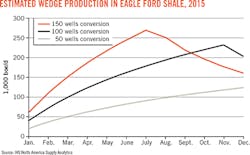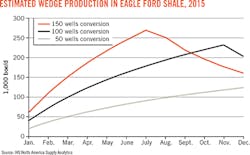Producers working in the South Texas Eagle Ford shale had built an inventory of nearly 1,400 drilled but uncompleted wells (DUC) as of Apr. 10, and IHS researchers said DUCs provide an economic strategy during the oil price downturn for many operators.
The most promising of the DUCs belong to a few Eagle Ford operators, giving them a likely advantage, said the IHS Energy "Analysis of Drilled But Uncompleted Wells in the Eagle Ford Shale."
The analysis concluded DUCs can be converted to producing assets for 65% of the cost of a new well, significantly lowering the economics when evaluated against remaining costs.
Nearly 40% of the 1,400 Eagle Ford DUCs are considered to have attractive economics (break-even costs below $30/bbl) and belong to a handful of operators, IHS said, adding 33 other operators account for the rest.
The operators owning most of the attractive DUC inventory include BHP Billiton Ltd., Chesapeake Energy Corp., Anadarko Petroleum Corp., EOG Resources Inc., ConocoPhillips, and Pioneer Natural Resources Co.
"In this low oil-price environment, operators in the Eagle Ford and other US shale plays are focused on optimizing the value of their assets and managing their costs, and these drilled but uncompleted wells enable them to do that more effectively for several reasons," said Raoul LeBlanc, IHS Energy senior director and lead author of the DUC analysis.
Completion costs dropping
"First, the drilling costs of these wells were already incurred by operators prior to 2015, and the completion costs, which comprise the majority of well costs, can be negotiated at a cheaper rate since completion crews are now both available and available at cheaper rates," LeBlanc said. "Second, if completion costs are fairly consistent in the play, then it stands to reason that wells with higher production will yield better returns on capital."
The DUC inventory is driven by the drilling sector outpacing the completion industry, IHS noted. As the rate of new wells drilled in the play falls, completion crews will be able to convert more wells to alleviate the DUC backlog.
Due to the shortened lead time of converting drilled but uncompleted wells, and the lower incremental costs of production from a DUC well, operators likely will be incentivized to work through DUC well inventories, IHS said.
Production expectations vary among wells in the DUC inventory. Due to differences in assets held by operators, the nature of DUC conversions also vary by company.
"Using a proprietary IHS neighbor algorithm, which takes into account certain performance metrics of nearby wells, IHS found that the DUC inventory quality closely aligns with historical operator performance, so these companies have performed well in the past," LeBlanc said.
"However, in terms of future performance in the Eagle Ford, IHS estimates that BHP, ConocoPhillips, and Pioneer Natural Resources have higher-quality DUC wells than their current producing well portfolios, providing them the greatest available options going forward of any operators in the play," he said.
To estimate the implication of these wells on 2015 production rates, IHS ran different conversion scenarios to assess the outcomes of bringing on stream DUC wells every month (See Figure, p. 1 of this issue).
IHS outlines possible conversion scenarios
LeBlanc estimated 1,100 DUC wells were available for conversion as of Apr. 10.
If the low-case conversion rate of 50 wells per month is achieved, IHS estimates that the DUC wedge (incremental) production would be 123,000 b/d at the end of a year, while a high-case conversion rate of 150 would result in a DUC wedge production of 269,000 b/d after 12 months.
Robert Fryklund, chief upstream strategist at IHS Energy and a coauthor of the DUC analysis, said the most desirable DUC wells are in the Northeast core sub-region of the Eagle Ford shale play.
"Operators such as EOG Resources, BHP Billiton, and ConocoPhillips have significant financial flexibility and greater options," Fryklund said.
He also noted that, "Operators who complete lower-productivity DUCs in the Eagle Ford west area may be challenged during the low-price environment, and a few may delay completions until oil prices rebound. The operators in the play with these DUCs will follow different strategies depending on their financial strengths, asset portfolios, degrees of hedging and their stakeholder demands in this low oil-price environment."
The process by which DUC inventories are reduced (if they are), will make operator strategies more transparent, IHS said, and most operators, particularly those with deep reductions in capital budgets and ambitious growth targets, will seek to liquidate DUCs in 2015 to deliver on production volumes.
A minority of operators likely will manage DUC conversions to shape growth in response to prices and costs.
"The volumes of these DUCs that are converted are meaningful because our IHS analysis indicates that the Eagle Ford DUC wedge production alone could generate an additional 180,000 b/d of oil in the second half of 2015," Fryklund said.
"That additional potential production represents approximately 14% of the play's annual production of 1.25 million b/d of oil," he said. "This further supports our IHS view that oil price fundamentals will face headwinds despite the collapsing rig count, and that a material price increase could lead to a supply response in late 2015 and 2016."


